
views
Using a Commercial Product

Use this method for the best results. Home cleaning remedies can be excellent, cheap solutions to many problems. Skunk spray, however, is one of the strongest and most stubborn smells you are likely to encounter. Spending money on a specialized cleaning product is recommended for permanent odor removal, without without any undesirable side effects. If you are not able to make a trip to the drugstore immediately, trying a different method first may be worth it, since the odor will be easiest to remove if you try as soon as possible. Light, indirect skunk sprays may also be removable with cheaper home remedies.

If the dog's eyes are red, flush them with cool water. If the dog has red, irritated eyes, it may be suffering from painful skunk spray in the face. Apply cool, clean water to the eyes by pouring from a cup, squirting with a turkey baster, or pouring from a gentle hose without any attachments to the end. You can also use an eye drop specific for dogs.

Purchase an enzyme cleaner for skunk odor removal. Be sure to purchase a pet-safe "enzyme based" or "enzymatic" cleaning product for skunk odor removal. Unlike other commercial odor removal products, enzyme cleaners actually break down and permanently remove the odor-causing substances, instead of just masking the smell under a stronger one. Do not use a skunk odor removal product that does not specifically state it is safe for use on pets.

Apply the product according to instructions. Many of these products can be applied as a spray directly on the dog's fur, but check the packaging instructions first. There is usually no need to use water or soap, as the enzymes will remain on the fur while dry and break down the odor over the course of a couple hours. Avoid spraying the dog's eyes or nose. If the smell is strong in the face, wet a cloth with the cleaning product and gently wipe the cheeks, forehead, and chin. If the dog has long fur and received a direct hit from the skunk spray, the odor may be trapped deeper in the coat. Use a cloth soaked in the cleaning solution to rub the dog's fur right down to the skin.
Using a Hydrogen Peroxide Mix
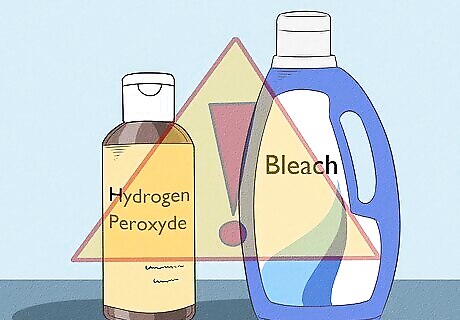
Be aware of the risks. This is probably the most effective home remedy, but there are significant downsides. Hydrogen peroxide can dry out your dog's skin and fur, burn your dog's eyes, or even bleach the dog's fur to a slightly lighter color. These risks are minimal if the solution is applied correctly, but you may wish to use a safer method on an uncooperative dog that will take a long time to wash. Some people find this method quite effective, especially when applied multiple times. However, for a direct skunk spray or a thick-coated dog, you may need a commercial cleaning product to remove the last vestiges of the smell.
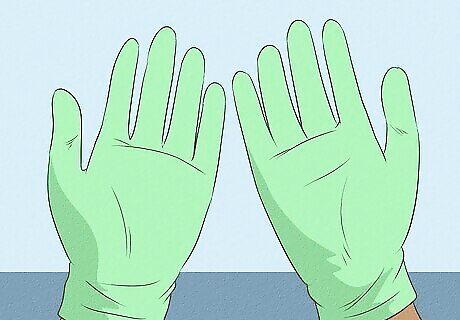
Put on old clothes and gloves. Skunk odor can easily rub off onto clothing. Put on disposable gloves and some old clothing before you begin treating your dog. You can often remove skunk odor from clothing in the laundry, by mixing ½ cup (120 mL) of baking soda mixed with ordinary laundry detergent. Using clothes you don't mind throwing away if necessary is still recommended, just in case. Do not mix "skunked" clothing with an ordinary load of laundry.
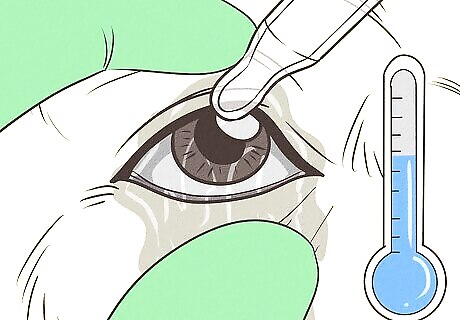
Flush irritated eyes with cool water. Pour clean, cool water over the dog's eyes if they are red and irritated from skunk spray. A turkey baster or garden hose without attachments may be helpful if the dog is shying away from the water.
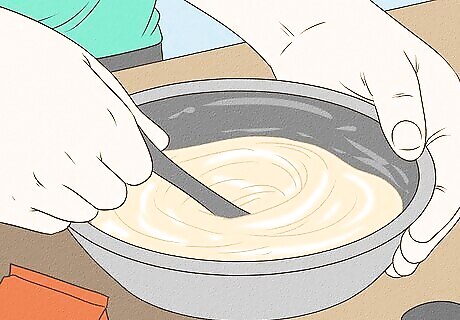
Mix a homemade odor removal mix. Mix together ¼ cup (60 mL) baking soda, 2 tsp (10 mL) dish washing soap, and 4 cups (960 mL) 3% hydrogen peroxide. If you do not have these materials, you may find them at a drugstore, or baking soda at a grocery store. This needs to be mixed directly before use, as it will quickly break down if left alone. Double this recipe for a large dog. If you only have more concentrated hydrogen peroxide, dilute it with additional water before adding to the other ingredients. For example, mix one part 9% hydrogen peroxide with two parts water to get 3% hydrogen peroxide. Stir thoroughly, then use 4 cups (960 mL) of this mixture in the above recipe.
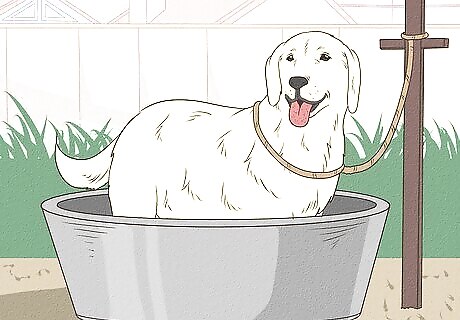
Keep the dog somewhere you can wash it. If weather and space permit, tie the dog up outside in a washtub. Skunk odor can easily spread to furniture, but if you need to wash the dog inside, lay down old towels or newspaper around the tub to make cleanup easier in case the dog struggles or jumps out.
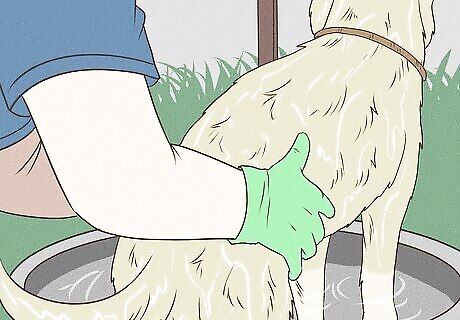
Rub in the mix from the collar back toward the tail. Wearing your disposable gloves, pour a little of the mix at a time on the dog, and massage it into the dog's fur, as though you were shampooing it. Start at the collar and work back to the tail. Keep the dog dry, as the hydrogen peroxide is less effective when wet.
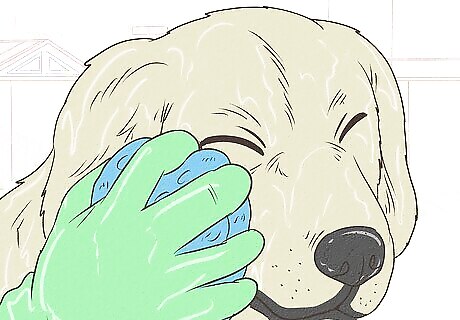
Use an old sponge to apply to the face (if necessary). If the face smells of skunk, tilt the dog's chin upward, so the liquid will run back to his neck, not forward into his eyes. Apply the peroxide with an old sponge, carefully, to the dog's chin, cheeks, forehead, and ears, but do not apply near eyes and nose. Optionally, you can protect the dog's ears by gently putting a cotton ball in each ear. Do not push them in far or jam them in hard. Some dogs (and people) dislike the feeling of liquid in their ears, so this may cause the dog to struggle less.

Rinse thoroughly within a couple minutes. Hydrogen peroxide may bleach your dog's fur slightly if left on too long, but it needs to be given some time to break down the skunk odor. Although this mixture is dilute, it should not be left on for longer than four minutes to reduce the chance of this happening. Hopefully, you will notice the smell lessen during this time.
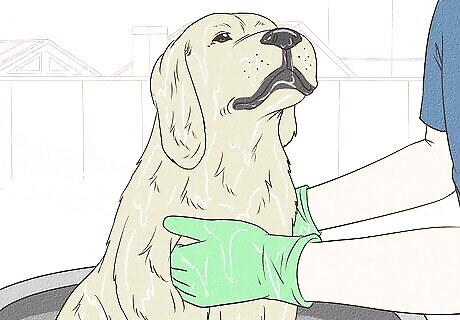
Repeat until odor is removed (if necessary). If you notice the smell has considerably decreased, but is not completely gone, let the dog dry out and apply the same mixture again. If the odor is not significantly reduced, however, you may be better off trying a commercial pet-safe skunk odor remover, or another home remedy.
Trying Other Methods

Use vinegar instead of hydrogen peroxide. White vinegar or apple cider vinegar can be mixed with baking soda and dishwashing soap, instead of hydrogen peroxide. This may be less effective, but does not have the risk of bleaching your dog's fur. Follow the instructions for hydrogen peroxide above, except where noted below: Vinegar will fizz immediately when mixed with baking soda, and quickly break apart. You may wish to rub the baking soda into the dog's fur, then pour on the vinegar.
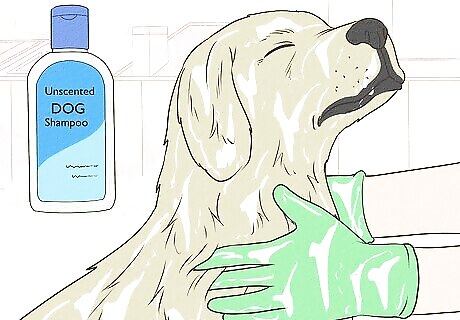
Use a scented pet shampoo to temporarily hide the scent. Massaging with scented pet shampoo will not remove the skunk oil permanently, but it may hide it temporarily. It is only useful as a short-term solution, unless you are willing to reapply it regularly. Skunk odor can take weeks to dissipate naturally, and may rub off onto clothing and furniture, so this is not recommended as a long-term solution. Tomato juice is not significantly more effective than scented shampoo, makes a mess, and can even stain your dog's fur slightly. Despite its popularity as a home remedy, it is not a good solution to skunk odor.
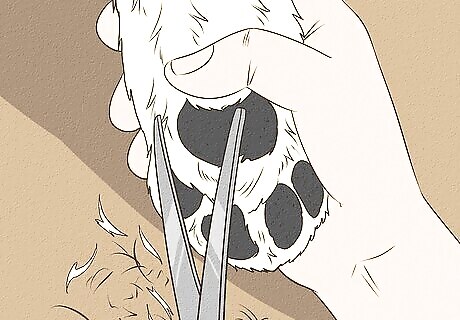
Trim long fur to remove trapped scent. Most of the scent may be trapped in the dog's fur, especially if it is long and the spray wasn't directly aimed at the dog. Trim the fur yourself or take the dog to a dog groomer who's willing to work around the smell of skunk.


















Comments
0 comment